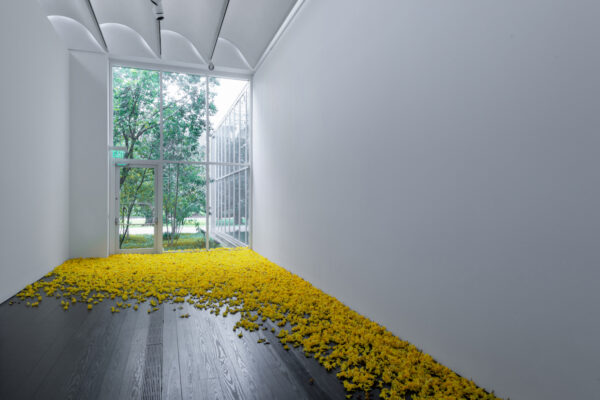
Installation view of Allora & Calzadilla, Graft, 2019, at the Menil Collection, Houston. Recycled polyvinyl chloride and paint, dimensions variable. Photo: Paul Hester
A cascade of delicate, yellow blossoms usher us into the far gallery at the Menil Collection in Houston, into Allora & Calzadilla’s delicious version of hell otherwise known as Specters of Noon. Indeed, Specters of Noon calls up centuries’ worth of folklore deeming noontime the most foreboding hour of the day. More specifically, the works that comprise Specters of Noon are intended to evoke the spirit of Acedia, the “noonday demon” said to infiltrate one’s soul at midday.
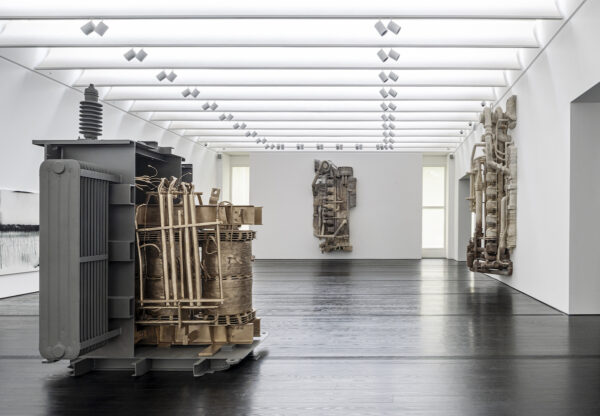
Installation view of Allora & Calzadilla’s Blackout, 2020. Power transformer, bronze, electricity, vocalists, 120 1/2 × 85 1/2 × 78 3/4 inches; and Manifest, 2020. Bat and bird guano, side A: 180 × 84 × 42.5 in., side B: 180 x 82 x 39 in. Commissioned by Leslie and Brad Bucher for exhibition at the Menil Collection; courtesy of Lisson Gallery, New York and London. Photo: Paul Hester
The strategic curvature of synthetic blossoms that make up Graft (2019) serves as a bright, eerie contrast to the incessant, deadened hum buried within the exploded electrical transformer of Blackout (2020), the post-apocalyptic, bat-shit totems of Manifest (2020), and the cancerous tree of coal that is Entelechy (2020). All of these works enmesh in us some kind of tantalizing and entrancing demise. However, my overarching problem with Specters of Noon’s seduction is that its constant fantasizing of the macabre has been fact-checked by our current reality.
Hundreds of thousands of people are dead. And for those of us who can still breathe, we are fully aware that we are living in a present-day dystopia. Like a charming and deceptive lover, Specters of Noon tells us all the right things — all the while not really listening to us or our experiences in any meaningful way. We’re left with a sense of remove, as if we’re looking at the work through the lens of a slick, highly produced Netflix series, as opposed to it feeling like a reflection of our actual lives. Because of that, the exhibition dilutes itself to mere entertainment and — even as excellently crafted as it is — misses an opportunity for the kind of connection, empathy, and catharsis that we all so desperately crave.
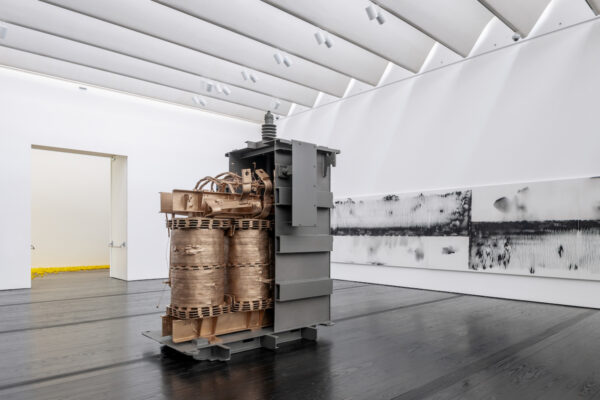
Installation view of Allora & Calzadilla’s Blackout, 2020. Power transformer, bronze, electricity, vocalists. Photo: Paul Hester
Where Allora & Calzadilla (a collaborative pair from Puerto Rico) botch this opportunity most, is, ironically, in the most authentic-to-form sculpture in the exhibition, titled Blackout. The piece is mostly an actual transformer recovered from Puerto Rico that exploded during Hurricane Maria in 2017. The artists left half the structure in its original steel and cast the other half in bronze, signifying the thematic midday divide that is noon.
The low, guttural hum that emanates from Blackout permeates the museum gallery — presses upon us, and eats at us from within. The revelation of its innards gives way to winding pipes and machinery, moving through its body like metal organs and intestines. So, here we are: Blackout is telling us all the right things. It’s pulling from an actual tragedy. It’s signifying the horrors of climate change and a federal government that offered lackluster to no assistance. It’s pointing to real life. So what’s the problem?
Even though the transformer is (mostly) real, its position in the space, front and center, and the formal quality of the broken wiring render Blackout more of a movie prop than a sculpture. Blackout is consumed with its own drama and storytelling to the point of devouring our sense of its authenticity.
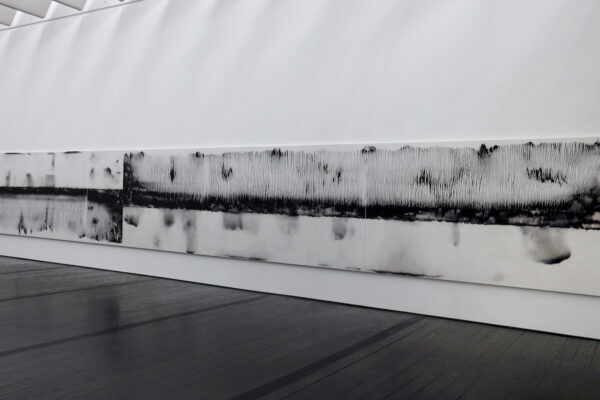
Installation view of Allora & Calzadilla’s Cadastre, 2019. Iron filings on linen, overall: 72 × 840 inches, each: 72 × 120 inches. Courtesy of Gladstone Gallery, New York and Brussels. Photo: Sarah Hobson
Cadastre (2019) does a better job of selling the drama without overdoing it. It spans 70 feet; Allora & Calzadilla created Cadastre by electromagnetically pulling iron fillings to one side of the canvas or the other. The iron fillings responded to the electromagnetism by spanning out from the center into lines, resulting in an arresting landscape of raining hellfire that sits somewhere between a drowning and an arrhythmia.
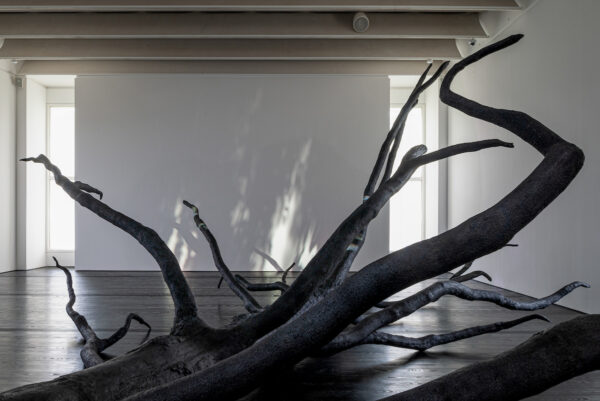
Installation view of Allora & Calzadilla’s Penumbra, 2020. Digital projection with sound, dimensions variable; and Entelechy, 2020. Coal, vocalists. Photo: Paul Hester
But, if all of the works in Specters of Noon behaved as subtly as Penumbra (2020), the exhibition as a whole would have been more powerful and disturbing. Penumbra is a digital recreation of light passing through foliage in the tropical forest of the Absalon Valley on Martinique. It’s equally menacing as every other piece in the exhibition, but its projection in the corner of the gallery lets it effectively commingle with the natural shadows coming in through the windows of the Menil in way that authentically connects to the world instead of presenting itself so theatrically. Its understated presence is frustrating, in a gratifying way — as if we keep trying to decipher what’s real and what isn’t, and sometimes land on a hint of truth. Penumbra feels slippery and just out of grasp, which speaks so cogently to our present moment. It’s a shame the rest of the work does not.
Through June 20, 2021 at the Menil Collection, Houston.


